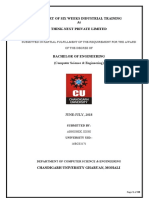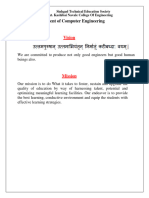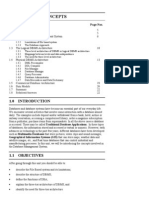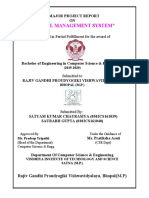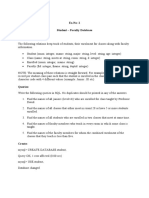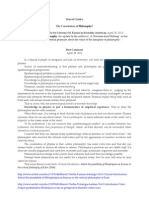0 ratings0% found this document useful (0 votes)
313 viewsAdvanced Python Programming Notes
deataile and specificity on python programming
Uploaded by
ashelwaps4Copyright
© © All Rights Reserved
We take content rights seriously. If you suspect this is your content, claim it here.
Available Formats
Download as DOCX, PDF, TXT or read online on Scribd
0 ratings0% found this document useful (0 votes)
313 viewsAdvanced Python Programming Notes
deataile and specificity on python programming
Uploaded by
ashelwaps4Copyright
© © All Rights Reserved
We take content rights seriously. If you suspect this is your content, claim it here.
Available Formats
Download as DOCX, PDF, TXT or read online on Scribd
You are on page 1/ 4
Advanced Python Programming Notes Outline
Page 1: Overview of Python Programming
Introduction to Python
o History and evolution of Python
o Python's philosophy and design principles
o Applications: web development, data science, automation, etc.
Basic Syntax Review
o Data types, variables, and operators
o Control flow (loops, conditionals)
o Functions and lambda expressions
Page 2: Object-Oriented Programming (OOP) in Python
Classes and Objects
o Defining classes, constructors, and instance methods
o Class variables vs. instance variables
Inheritance and Polymorphism
o Single and multiple inheritance
o Overriding methods and the super() function
Special Methods (Magic Methods)
o Operator overloading (__add__, __str__, etc.)
o Using __new__, __init__, and __del__
Page 3: Advanced Class Design
Encapsulation and Properties
o Getters and setters using @property
o Private, protected, and public members
Decorators and Metaclasses
o Class decorators (@classmethod, @staticmethod)
o Custom metaclasses and use cases
Dynamic Attribute Access
o __getattr__, __setattr__, __dir__
Page 4: Functional Programming Concepts
Higher-Order Functions
o Using functions as arguments and returning functions
Map, Filter, and Reduce
o Functional operations for data processing
Lambda Functions and Closures
o Creating anonymous functions
o Use cases for closures in callbacks
List Comprehensions and Generator Expressions
o Writing concise list comprehensions
o Lazy evaluation with generators
Page 5: Modules and Packages
Creating and Using Modules
o Importing built-in and custom modules
o Understanding __name__ and module execution
Organizing Code with Packages
o Structuring code into packages and subpackages
Virtual Environments and Package Management
o Using venv and pip for managing dependencies
o Installing and publishing packages with PyPI
Page 6: Exception Handling and Debugging
Exception Handling Mechanisms
o try, except, else, finally clauses
o Custom exceptions and raising exceptions
Logging and Debugging Techniques
o Using logging for debugging and tracking issues
o Python's pdb module for interactive debugging
Assertions and Unit Testing
o Using assert statements for testing conditions
o Writing tests with the unittest and pytest libraries
Page 7: Data Structures and Algorithms
Built-in Data Structures
o Lists, tuples, sets, dictionaries
o Using collections module (deque, Counter, namedtuple)
Advanced Data Structures
o Implementing linked lists, trees, and graphs
o Binary search trees and hash tables
Algorithm Techniques
o Sorting and searching algorithms
o Dynamic programming and recursion
Page 8: Asynchronous Programming
Asyncio Library
o Understanding coroutines and the async/await syntax
o Event loops and tasks
Concurrent Futures and Threading
o Using concurrent.futures for multi-threading
o Parallelism with multiprocessing module
Event-Driven Programming
o Implementing callbacks and event loops
o Use cases in web servers and GUIs
Page 9: Metaprogramming and Reflection
Dynamic Code Execution
o Using exec() and eval()
Introspection and Reflection
o Accessing and modifying object attributes dynamically
o Working with getattr(), setattr(), and dir()
Using Decorators and Context Managers
o Writing custom decorators
o Managing resources with with and context managers (__enter__, __exit__)
Page 10: Data Science and Machine Learning with Python
Data Analysis Libraries
o Using NumPy for numerical computing
o Data manipulation with pandas
Data Visualization
o Creating plots with matplotlib and seaborn
Machine Learning Libraries
o Overview of scikit-learn for basic ML algorithms
o Introduction to deep learning with TensorFlow and PyTorch
Jupyter Notebooks and Interactive Computing
o Using Jupyter for data analysis and visualization
o Interactive widgets and dashboards
You might also like
- E-Housing Helping System: Ms. Muskaan ShaikhNo ratings yetE-Housing Helping System: Ms. Muskaan Shaikh26 pages
- A Report of Six Weeks Industrial Training at Think-Next Private LimitedNo ratings yetA Report of Six Weeks Industrial Training at Think-Next Private Limited30 pages
- Currency Conversion Project Report in Python (1)No ratings yetCurrency Conversion Project Report in Python (1)118 pages
- HOSPITAL MANAGEMENT SYSTEM MINI PROJECT PPTNo ratings yetHOSPITAL MANAGEMENT SYSTEM MINI PROJECT PPT32 pages
- Django School Management Report and Documentation (1) - 1No ratings yetDjango School Management Report and Documentation (1) - 153 pages
- Health & Fitness Club Management App: 1) Background/ Problem StatementNo ratings yetHealth & Fitness Club Management App: 1) Background/ Problem Statement9 pages
- TEACHING AND EVALUATION SCHEME FOR 5th Semester (CSE) (Wef 2020-21)No ratings yetTEACHING AND EVALUATION SCHEME FOR 5th Semester (CSE) (Wef 2020-21)25 pages
- Gujarat Technological University: Prime Institute of Engineering and TechnologyNo ratings yetGujarat Technological University: Prime Institute of Engineering and Technology49 pages
- Pds Full Asiignment Mam - 240926 - 123334No ratings yetPds Full Asiignment Mam - 240926 - 12333415 pages
- Synopsis Online Book Shopping System v1.0No ratings yetSynopsis Online Book Shopping System v1.07 pages
- Practical:-2 Aim:-Develop Programs To Learn Different Types of Structures (List, Dictionary, Tuples) in PythonNo ratings yetPractical:-2 Aim:-Develop Programs To Learn Different Types of Structures (List, Dictionary, Tuples) in Python11 pages
- Computer Based Optimization Technique MCA-315No ratings yetComputer Based Optimization Technique MCA-3157 pages
- Aisect University Hazaribag: A Presentation On Hostel Management SystemNo ratings yetAisect University Hazaribag: A Presentation On Hostel Management System26 pages
- Chapter 9 (Machine-Independent Optimizations)No ratings yetChapter 9 (Machine-Independent Optimizations)37 pages
- Web Deveopment: Vivekananda Global University, JaipurNo ratings yetWeb Deveopment: Vivekananda Global University, Jaipur41 pages
- Enterprise Computing With Java Practical File: Master of Computer ApplicationNo ratings yetEnterprise Computing With Java Practical File: Master of Computer Application45 pages
- Object Oriented Programming Coursework For Endterm: OtodecksNo ratings yetObject Oriented Programming Coursework For Endterm: Otodecks6 pages
- Java Fundamentals Made Easy: A Practical Guide with ExamplesFrom EverandJava Fundamentals Made Easy: A Practical Guide with ExamplesNo ratings yet
- CM3140 en Balancing Module - Three Point Circle Method 090611No ratings yetCM3140 en Balancing Module - Three Point Circle Method 0906116 pages
- DBCU - Net Deep Learning Approach For Segmentation of Coronary Angiography ImagesNo ratings yetDBCU - Net Deep Learning Approach For Segmentation of Coronary Angiography Images9 pages
- Roll No.: 31 Aryabhatta Inter-School Mathematics Competition - 2014100% (1)Roll No.: 31 Aryabhatta Inter-School Mathematics Competition - 201410 pages
- External Cathodic Protection of Well Casings: British Standard Bs en 15112:2006No ratings yetExternal Cathodic Protection of Well Casings: British Standard Bs en 15112:200639 pages
- Semi Detailed Lesson Plan in AccelerationNo ratings yetSemi Detailed Lesson Plan in Acceleration4 pages
- Ferrari, Basko - 2013 - Supplementary Information Supplementary Information For "Raman Spectroscopy As A Versatile Tool For StudyingNo ratings yetFerrari, Basko - 2013 - Supplementary Information Supplementary Information For "Raman Spectroscopy As A Versatile Tool For Studying13 pages
- 2024-12-02_02-06-37.0587_-0500-20550fb17139528d2e0ea458f73a8bbe7748d717No ratings yet2024-12-02_02-06-37.0587_-0500-20550fb17139528d2e0ea458f73a8bbe7748d71714 pages
- All Saints School, Agra: Practical File Computer Science (083) Session: 2020-21No ratings yetAll Saints School, Agra: Practical File Computer Science (083) Session: 2020-2120 pages
- High-Quality Audio Applications Using The PIC32: Author: Jayanth Murthy Madapura Microchip Technology IncNo ratings yetHigh-Quality Audio Applications Using The PIC32: Author: Jayanth Murthy Madapura Microchip Technology Inc16 pages
- Fundamentals of Mathematics 9th Enhanced Edition James Van Dyke All Chapters Instant Download100% (12)Fundamentals of Mathematics 9th Enhanced Edition James Van Dyke All Chapters Instant Download81 pages
- Programmable System On Chip Psoc Usage in Embedded Programming CoursesNo ratings yetProgrammable System On Chip Psoc Usage in Embedded Programming Courses15 pages
- Reactions of 2-Bromo-4-Phenylcyclohexanols With Base and Silver OxideNo ratings yetReactions of 2-Bromo-4-Phenylcyclohexanols With Base and Silver Oxide13 pages
- Marcel Chelba - The Consolation of Philosophy? (Comment On An Article by Lawrence M. Krauss: The Consolation of Philosophy)No ratings yetMarcel Chelba - The Consolation of Philosophy? (Comment On An Article by Lawrence M. Krauss: The Consolation of Philosophy)6 pages
- 156 - Engineering - Drawing - EE-155 - Lab - Manual Final-2No ratings yet156 - Engineering - Drawing - EE-155 - Lab - Manual Final-224 pages
- Alberti & Marshall (2009) - Animating ArchaeologyNo ratings yetAlberti & Marshall (2009) - Animating Archaeology13 pages






